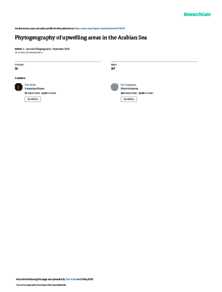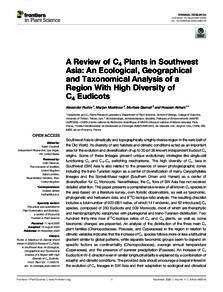وثيقة
Phytogeography of upwelling areas in the Arabian Sea.
المعرف
DOI: 10.1046/j.1365-2699.2003.00933.x
المصدر
Journal of Biogeography. v. 30, 9, p. 1339-1356
المساهمون
Coppejans, Eric., مؤلف
الدولة
United Kingdom.
مكان النشر
Oxford
الناشر
Blackwell
ميلادي
2003-09-01
اللغة
الأنجليزية
الملخص الإنجليزي
Aim: The identification of the marine plant communities of two islands from different upwelling areas of the Arabian Sea, with a similar diversity in biotopes. A comparison of the species composition of these macroalgal communities and their biogeographical affinities within the Indian Ocean should give insight into the biogeographical position of the Arabian Sea within the larger Indian Ocean. The incorporation of environmental parameters in the analysis is instructive in understanding their importance in shaping the diverse marine assemblages of the Arabian Sea. Location: Arabian Sea: (1) the Socotra Archipelago (Yemen; 12.47°N, 53.87°E) in the Somali upwelling area, (2) Masirah Island (Oman; 20.42°N, 58.79°E) in the upwelling area of the southern Arabian Peninsula. Methods: The marine flora of different biotopes around both islands were examined by means of qualitative assessments. Ordination analysis [detrended correspondence analysis (DCA)] was used to identify the different plant communities and to correlate these with environmental parameters. The species composition of the identified communities were compared (tripartite similarity index) and their biogeographical affinity with nations bordering the Indian Ocean was determined. Indicator species analyses were performed to identify the characteristic species of the different plant communities and their biotopes. Results: The DCA analysis shows a clustering of sites (plant communities) corresponding with their geographical position, linked in turn to the prevailing environmental conditions of the different coastal areas. The combined interpretation of the ordination, similarity and biogeographical analyses results in the aggregation of similar plant communities of both upwelling areas into four biotopes. Main conclusions: The north coast communities of Socotra and the west coast communities of Masirah can be grouped into three biotopes related to the degree of exposure (to upwelling) and sedimentation. These biotopes are typified by indicator species, characteristic for specific substrata, and have a high biogeographical affinity with the East African coast. The plant communities of Socotra's south coast and Masirah's east coast constitute a fourth biotope, being diverse and species rich, typified by a large proportion of red macroalgae including the characteristic species of the unique Arabian Sea flora. This biotope has a pronounced biogeographical affinity with distant regions (disjunctly distributed taxa) as South Africa's East Coast and Western Australia. Within the different biotopes, the communities of Masirah are more divergent from an East African flora in comparison to Socotra, the latter being a stepping stone between the East African and Arabian Sea flora.
ISSN
0305-0270
قالب العنصر
مقالات الدوريات


